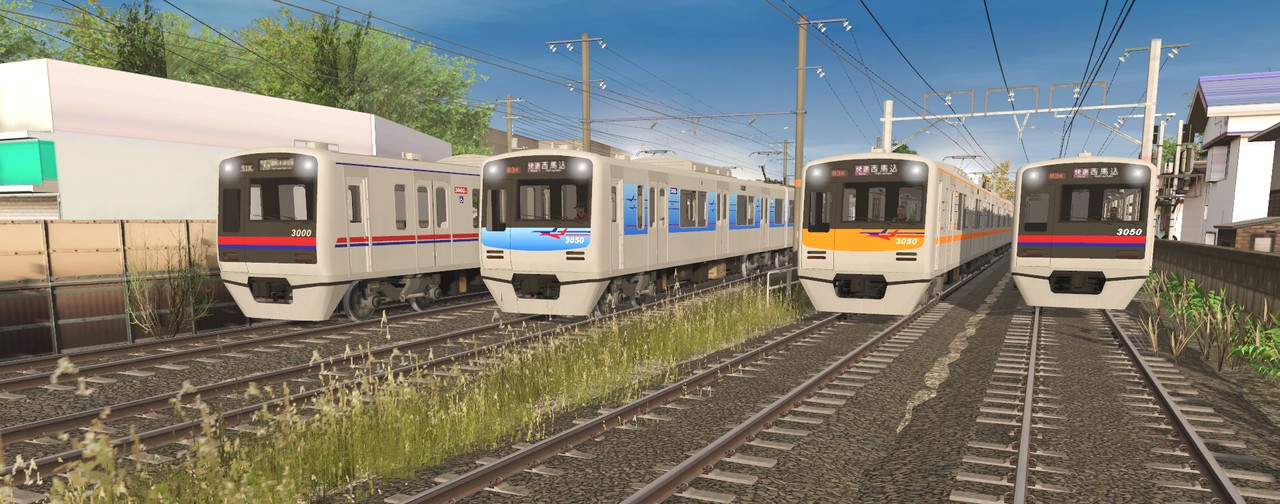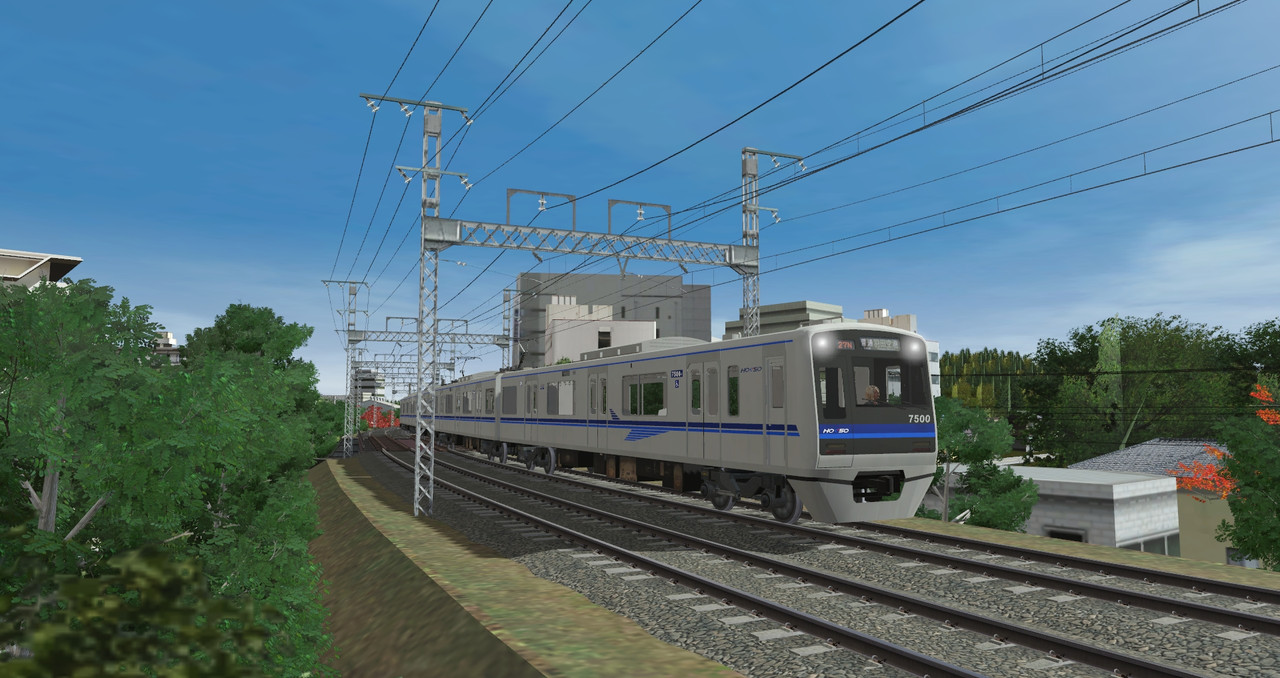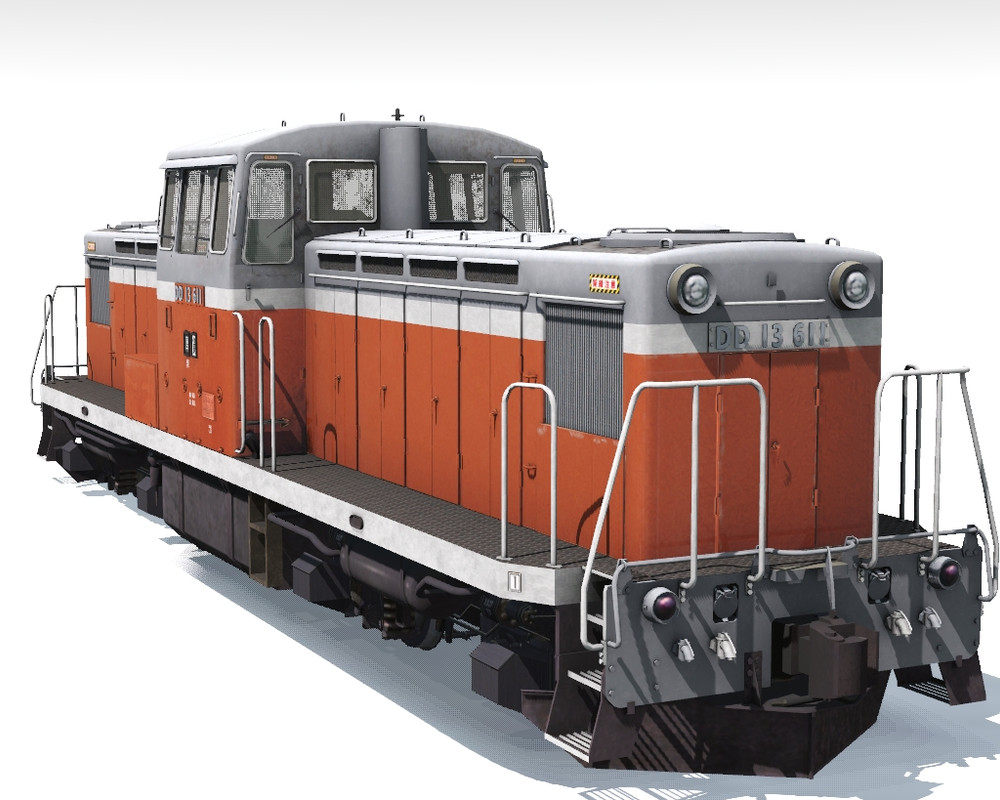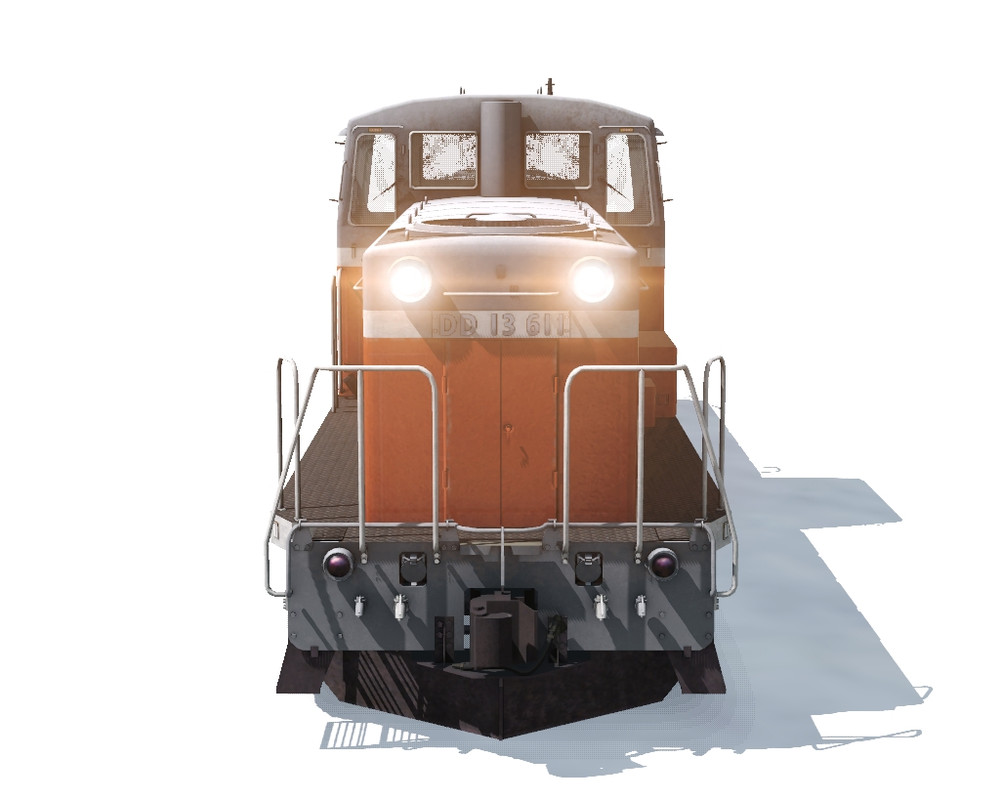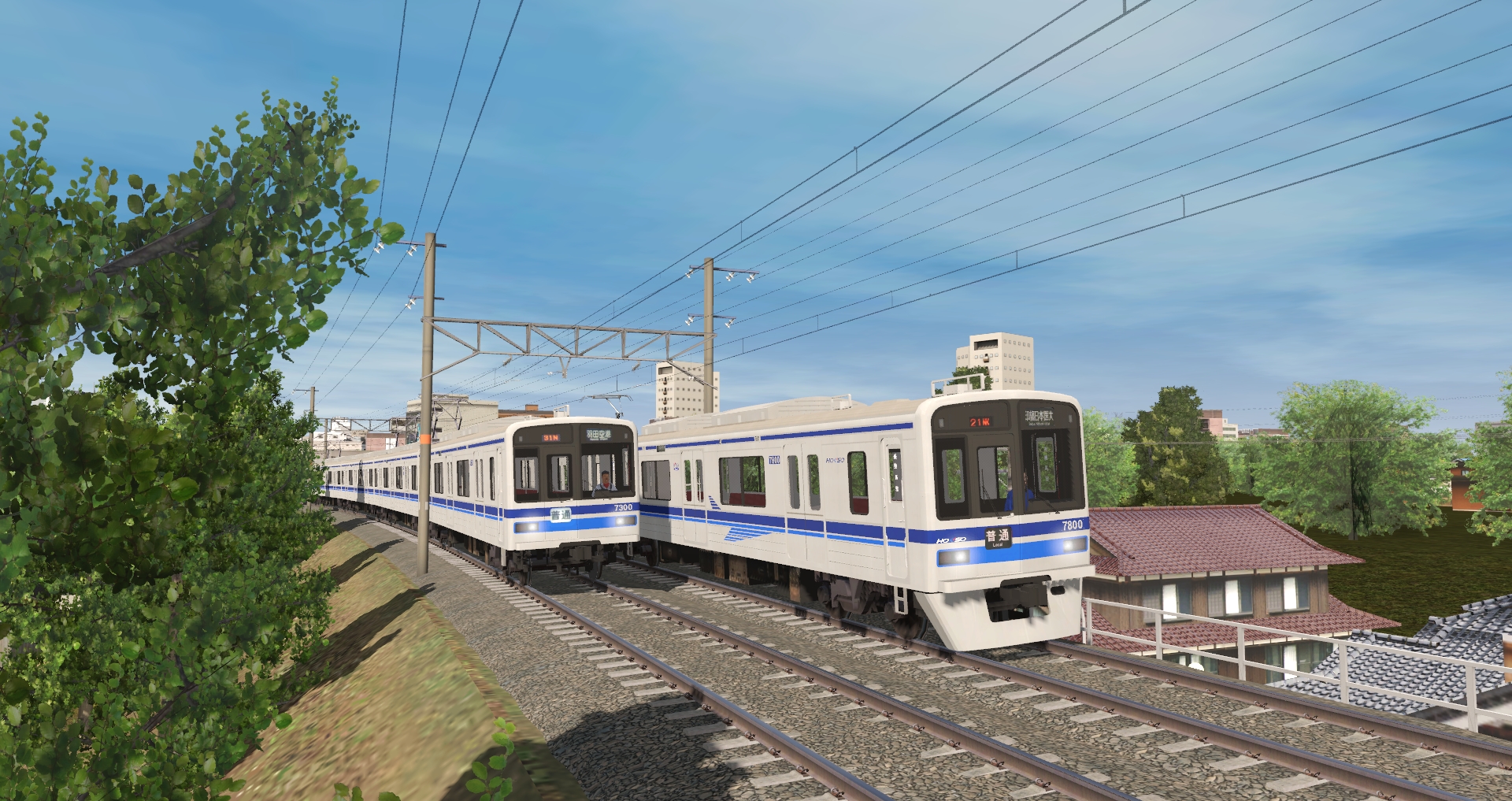[continues from previous post]
As part of this plans, 2000 Series sets started to undergo a rather "invasive" modification and conversion process, wich involved the "cutting out" a hole for a third door in the center of the bodyshell, and then welding the actual doorway to it (and consequently rearranging the passenger windows) along with changing the interiors from the limited express-style cross-seating to more conventional longitudinal-style seating more suited for a commuter train. The first train to be converted was the first 2000 Series set ever produced, 2011F, at the hands of Tokyu Car Corporation, one of it's two original manufacturers. All the other conversions would be handled by Keikyu's own Keikyu Car Corporation (currently Keikyu Finetech), a subsidiary company that handles rolling stock modifications and conversions, normally on second-hand stock bought by small third-sector railways.
Among other modifications, the 2000 Series sets were also adapted for multiple-unit working with all of Keikyu's subsequent serieses - the 1500, (New) 600, 2100 and New 1000 Serieses.
Converted trains promptly re-entered services fitted in Keikyu's all-over red with a thin-white line livery, running local services on the Keikyu Main Line, alongside with rapid and express services on the Airport Line. The 2000 Series however remained confined to the Keikyu network only, as due to it's lack of a front emergency escape door, required by law, could not enter Sengakuji station, nor run trough-services further along the Toei Asakusa Line.
The last remaining set, 2051F, was retired from skip-stop services on the 27th of August 2000 and sent for conversion.
"Demoted" to commuter services, the 2000 Series' life remained relatively uneventful for several years, shuttling up and down the Keikyu mainline and it's branches on all kinds of services, including rapid and express runs, where the high-speed capabilities of the 2000 Series could be fully used.
However, the vast majority of services allocated were all-stop local runs, wich quickly began to take a toll on the 2000 Series' equipment, primarily the transmission gearing, wich had been designed for high-speeds, rather than high accellerations: the result was a slugghish accelleration as well as premature wear on vital components. Furthemore, with Keikyu's increasingly trough-running-focused service planning, the subway regulations non-compliance of the 2000 Series began to be a problem.
As such, a replacement finally began in 2012 at the hands of the various batches of the New 1000 Series that were being introduced at the same time. Priority was given to the four-car sets, with sets 2411F, 2421F and 2431F being retired on the 4th of May.
One year later, for it's 30th Anniversary (as well as for the whole series), set 2011F was repainted in it's original "express" livery (all-over red with a wide white band around the windows), entering service in it's new guise on the 17th of January 2013.
Withdrawals however continued, with 8-car set 2021F being withdrawn on the 3rd of July 2014, 4-car sets 2441F and 2461F being retired on the 4th of March 2016, being followed by the last remaining 4-car set, 2451F, withdrawn on the 12th of October after a brief stint on the Daishi Line immediately before it's retirement.
Sets 2031F and 2041F were retired in 2017, on the 7th of February and 8th of March respectively and in 2018 all three remaining sets were retired: 2051F on the 1st of February, 2061F on the 15th of March and finally 2011F, wich was retired on the 28th of March after it's final run, having the distinction of being both the first and last 2000 Series set in service.
Unfortunately, all cars were scrapped immediately after retirement, with none being sold on the second-hand market, nor preserved.
Trivia #1
The idea of foldable "strapountins" was allegedly inspired by their usage in France, with the SNCF Z6400 Series (introduced in 1976 on commuter services out of Paris Saint-Lazare station) being the main basis for Keikyu's adoption.
Trivia #2
The 2000 Series was the recipient of the 1983 "Blue Ribbon", a prize awared by the Japan Railfan Club to trains with the most outstanding fetaures or technical improvements.
Trivia #3
Surplus seats from the 2000 Series' conversion were re-used in the earliest five batches of the New 1000 Series, wich were being introduced at around the same as the ongoing conversion process.
A sizeable number of seats were also put on sale on the second-hand marked, where they found a number of buyers, among wich the Railway Technical Research Institute (the Research and Development arm of the JR Group), wich fitted them to it's 1st generation "Gauge Change Train" prototype (GCT-01), the Tokyo Tourism College, where they were used as teaching materials in a number of railway-related courses and most interestingly, the US Navy, wich installed them in it's fleet of shuttle busses running from the Yokosuka Navy Base to a number of off-base housing complexes, such as Ikego Housing Office, wich is ironically located right across from Jimmuji Station on the Keikyu Zushi Line (the station even has a dedicated exit reserved for US Navy servicemen and other Navy credential holders).
As part of this plans, 2000 Series sets started to undergo a rather "invasive" modification and conversion process, wich involved the "cutting out" a hole for a third door in the center of the bodyshell, and then welding the actual doorway to it (and consequently rearranging the passenger windows) along with changing the interiors from the limited express-style cross-seating to more conventional longitudinal-style seating more suited for a commuter train. The first train to be converted was the first 2000 Series set ever produced, 2011F, at the hands of Tokyu Car Corporation, one of it's two original manufacturers. All the other conversions would be handled by Keikyu's own Keikyu Car Corporation (currently Keikyu Finetech), a subsidiary company that handles rolling stock modifications and conversions, normally on second-hand stock bought by small third-sector railways.
Among other modifications, the 2000 Series sets were also adapted for multiple-unit working with all of Keikyu's subsequent serieses - the 1500, (New) 600, 2100 and New 1000 Serieses.
Converted trains promptly re-entered services fitted in Keikyu's all-over red with a thin-white line livery, running local services on the Keikyu Main Line, alongside with rapid and express services on the Airport Line. The 2000 Series however remained confined to the Keikyu network only, as due to it's lack of a front emergency escape door, required by law, could not enter Sengakuji station, nor run trough-services further along the Toei Asakusa Line.
The last remaining set, 2051F, was retired from skip-stop services on the 27th of August 2000 and sent for conversion.
"Demoted" to commuter services, the 2000 Series' life remained relatively uneventful for several years, shuttling up and down the Keikyu mainline and it's branches on all kinds of services, including rapid and express runs, where the high-speed capabilities of the 2000 Series could be fully used.
However, the vast majority of services allocated were all-stop local runs, wich quickly began to take a toll on the 2000 Series' equipment, primarily the transmission gearing, wich had been designed for high-speeds, rather than high accellerations: the result was a slugghish accelleration as well as premature wear on vital components. Furthemore, with Keikyu's increasingly trough-running-focused service planning, the subway regulations non-compliance of the 2000 Series began to be a problem.
As such, a replacement finally began in 2012 at the hands of the various batches of the New 1000 Series that were being introduced at the same time. Priority was given to the four-car sets, with sets 2411F, 2421F and 2431F being retired on the 4th of May.
One year later, for it's 30th Anniversary (as well as for the whole series), set 2011F was repainted in it's original "express" livery (all-over red with a wide white band around the windows), entering service in it's new guise on the 17th of January 2013.
Withdrawals however continued, with 8-car set 2021F being withdrawn on the 3rd of July 2014, 4-car sets 2441F and 2461F being retired on the 4th of March 2016, being followed by the last remaining 4-car set, 2451F, withdrawn on the 12th of October after a brief stint on the Daishi Line immediately before it's retirement.
Sets 2031F and 2041F were retired in 2017, on the 7th of February and 8th of March respectively and in 2018 all three remaining sets were retired: 2051F on the 1st of February, 2061F on the 15th of March and finally 2011F, wich was retired on the 28th of March after it's final run, having the distinction of being both the first and last 2000 Series set in service.
Unfortunately, all cars were scrapped immediately after retirement, with none being sold on the second-hand market, nor preserved.
Trivia #1
The idea of foldable "strapountins" was allegedly inspired by their usage in France, with the SNCF Z6400 Series (introduced in 1976 on commuter services out of Paris Saint-Lazare station) being the main basis for Keikyu's adoption.
Trivia #2
The 2000 Series was the recipient of the 1983 "Blue Ribbon", a prize awared by the Japan Railfan Club to trains with the most outstanding fetaures or technical improvements.
Trivia #3
Surplus seats from the 2000 Series' conversion were re-used in the earliest five batches of the New 1000 Series, wich were being introduced at around the same as the ongoing conversion process.
A sizeable number of seats were also put on sale on the second-hand marked, where they found a number of buyers, among wich the Railway Technical Research Institute (the Research and Development arm of the JR Group), wich fitted them to it's 1st generation "Gauge Change Train" prototype (GCT-01), the Tokyo Tourism College, where they were used as teaching materials in a number of railway-related courses and most interestingly, the US Navy, wich installed them in it's fleet of shuttle busses running from the Yokosuka Navy Base to a number of off-base housing complexes, such as Ikego Housing Office, wich is ironically located right across from Jimmuji Station on the Keikyu Zushi Line (the station even has a dedicated exit reserved for US Navy servicemen and other Navy credential holders).
Last edited:


